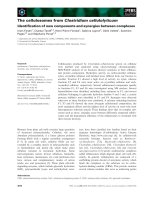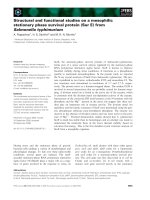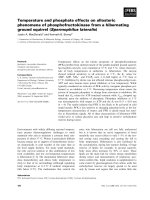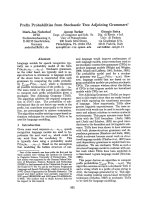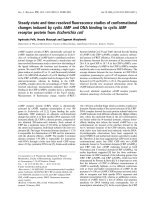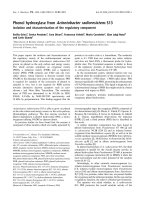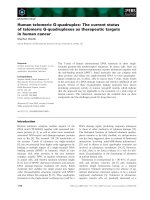Báo cáo khoa học: "Bony metastases from breast cancer - a study of foetal antigen 2 as a blood tumour markerl" doc
Bạn đang xem bản rút gọn của tài liệu. Xem và tải ngay bản đầy đủ của tài liệu tại đây (371.82 KB, 4 trang )
WORLD JOURNAL OF
SURGICAL ONCOLOGY
Cheung et al. World Journal of Surgical Oncology 2010, 8:38
/>Open Access
RESEARCH
BioMed Central
© 2010 Cheung et al; licensee BioMed Central Ltd. This is an Open Access article distributed under the terms of the Creative Commons
Attribution License ( which permits unrestricted use, distribution, and reproduction in
any medium, provided the original work is properly cited.
Research
Bony metastases from breast cancer - a study of
foetal antigen 2 as a blood tumour marker
Kwok-Leung Cheung*
1
, Ray K Iles
2
and John FR Robertson
1
Abstract
Background: Foetal antigen 2 (FA-2), first isolated in the amniotic fluid, was shown to be the circulating form of the
aminopropeptide of the alpha 1 chain of procollagen type I. Serum concentrations of FA-2 appeared to be elevated in
a number of disorders of bone metabolism. This paper is the first report of its role as a marker of bone metabolism in
metastatic breast cancer.
Methods: Serum FA-2 concentrations were measured by radioimmunoassay in 153 women with different stages of
breast cancer and in 34 normal controls.
Results: Serum FA-2 was significantly elevated in women with bony metastases (p < 0.015). Its levels were not
significantly different among women with non-bony metastases, with non-metastatic disease, as well as among
normal controls.
Conclusions: FA-2 is a promising blood marker of bone metabolism. Further studies to delineate its role in the
diagnosis and management of bony metastases from breast cancer are required.
Background
Foetal antigen 2 (FA-2) was first isolated in the amniotic
fluid [1] and subsequent structural characterisation
showed that it was the circulating form of the aminopro-
peptide of the alpha 1 chain of procollagen type I [2]. As
will be discussed later, serum concentrations of FA-2
appeared to be elevated in a number of disorders with
altered bone metabolism. The bone is the commonest site
of involvement in metastatic breast cancer. Bone metabo-
lism, including formation and resorption, is influenced by
the disease process, by anti-cancer therapies (cytotoxic or
endocrine therapy) and by the recently popularised use of
bisphosphonates. A circulating marker which can better
reflect the process of bone metabolism is needed in the
management of women with bony metastases from
breast cancer, in addition to currently available markers
of tumour load (eg MUC1 mucin measured as cancer
antigen 15.3 (CA15.3), carcinoembryonic antigen (CEA)).
FA-2 seems to be a promising marker of such kind. This
paper analyses the serum levels of FA-2 in different stages
of breast cancer and examines its role as a marker of bone
metabolism in metastatic breast cancer.
Methods
Patients
Blood samples were obtained with informed consents
from the following four groups of women seen in the
Nottingham Breast Unit:
1. Normal - This included women from two sources.
The first group were women attending the Screening
Assessment Clinic according to the UK National Health
Service Breast Screening Programme and were proven
after assessment (clinical, radiological and/or histologi-
cal) to have no malignancy in the breast. The second
group of women attended the Benign Lumps Clinic and
they had been proven by investigations (including imag-
ing and histology) to have either benign lump(s) or no
abnormality in the breast.
2. Women with primary breast cancer (PBC) - All had
tumour < 5 cm and blood samples were taken at the pre-
operative assessment clinic prior to surgery.
3. Women with locally advanced primary breast cancer
(LAPC) - These women had LAPC as defined by having
tumour > 5 cm and/or other features of locally advanced
disease (eg inflammatory cancer, fixation to chest wall,
ulcerating tumour) without any evidence of distant
metastases and attended the LAPC Clinic. Blood samples
were taken when the tumour was still in situ.
* Correspondence:
1
Division of Breast Surgery, University of Nottingham, Nottingham, UK
Full list of author information is available at the end of the article
Cheung et al. World Journal of Surgical Oncology 2010, 8:38
/>Page 2 of 4
4. Women with advanced breast cancer (ABC) - These
were women attending the ABC Clinic and all had distant
metastases.
Preparation of Serum Samples
Blood obtained by venesection was collected in plain
tubes, allowed to stand for at least 30 minutes and then
centrifuged at 2,500 revolutions per minute for 20 min-
utes. Serum was pipetted into 1-ml aliquots and stored in
the freezer at -20°C.
FA-2 Assays
The serum samples were transported at -20°C to the Wil-
liamson Laboratory at St Bartholomew's Hospital. FA-2
radioimmunoassays were carried out as previously
described [3]. The assays were performed in a blind man-
ner with aliquots tagged with a sample number without
any clinical information.
Statistical Methods
Statistical analysis was carried out using the standardised
biomedical computer programme SPSS for Windows
(SPSS UK Ltd). The ANOVA test was used for multiple
group comparison of the mean values. Statistically signif-
icant difference was defined by p < 0.05.
The authors confirm that approval has been obtained
from Local Research Ethics Committee to conduct this
study on blood markers in breast cancer.
Results
The mean values of serum FA-2 levels in all four groups
of women were summarised in Table 1. There was no dif-
ference in FA-2 levels among normal women and women
with breast cancer which was still confined to the breast
(ie PBC and LAPC) (Tables 1 and 2). Nevertheless, when
all stages of cancer were taken into consideration, FA-2
levels appeared to be significantly elevated in cancer
patients when compared to normal women and this was
due to marked elevation in women with metastatic breast
cancer (Table 2). Women with metastatic disease had a
much higher value of FA-2 than those without (Table 3)
and this was due to the significant elevation of FA-2 in
women with bony metastases (Figure 1).
In conclusion, the results suggested that FA-2 was sig-
nificantly elevated only in the subgroup of women with
bony metastases.
Discussion
Blood tumour markers in breast cancer have been known
for decades. In contrast to markers in the primary
tumour tissue, blood tumour markers reflect a dynamic
situation and their measurements can be repeated as
required. The use of blood tumour markers is most estab-
lished in the diagnosis and monitoring of symptomatic
metastatic disease. In the diagnosis of metastatic breast
Table 1: Mean Values of FA-2 for All Women
Sample category N Mean ± SD
(AU/ml)
Normal 34 0.21 ± 0.09
PBC 35 0.18 ± 0.08
LAPC 38 0.33 ± 0.67
ABC 80 0.85 ± 1.34
All 187
Figure 1 Comparison of FA-2 levels between bone and non-bone
metastases.
Sample category N
Mean ± SD
(AU/ml)
p value
Non-bony metastases
Bony metastases*
20
53
0.37 ± 0.36
0.91 ± 0.94
0.0149
* Including patients with both skeletal and extra-skeletal metastases.
non-bon e bone
Metastases
0. 00
1. 00
2. 00
3. 00
4. 00
A
U
p
e
r
m
l
$
$
$
$
$
$
$
$
$
$
$
$
$
$
$
$
$
$
$
$
$
$
$
$
$
$
$
$
$
$
$
$
$
$
$
$
$
$
$
$
$
$
$
$
$
$
$
$
$
$
$
$
$
$
$
$
$
$
$
$
$
$
$
$
$
$
$
$
$
$
$
$
$
Cheung et al. World Journal of Surgical Oncology 2010, 8:38
/>Page 3 of 4
cancer, CA15.3 assay has been shown to be superior with
CEA being the next most clinically useful marker [4]. The
sensitivity can be further increased when a panel of three
markers ie CA15.3, CEA and ESR are used [5-8]. While
the usefulness of blood tumour markers is well estab-
lished in advanced breast cancer, active research, both
clinical and laboratory, is ongoing to refine the measure-
ments of existing markers, to explore newer markers and
to develop better marker assays, aiming to optimise their
use in advanced disease as well as to exploit their use in
screening and diagnosis of early primary breast cancer.
Markers of bone metabolism are among the new mark-
ers which are being investigated. Traditional markers of
bone metabolism include serum alkaline phosphatase,
serum and urinary calcium, urinary hydroxproline etc.
Markers of collagen synthesis have been evaluated as
bone markers for metastatic bone disease due to breast
cancer. The most abundant protein in bone is type I colla-
gen. During its formation two extension peptides from
the procollagen molecule, carboxy- and aminoterminal
propeptides (PICP and PINP) are released into the circu-
lation and they are markers of bone formation. Type I col-
lagen carboxyterminal telopeptide (ICTP) is formed
during bone collagen breakdown and is again liberated
into the circulation. Its level in the serum therefore
reflects bone resorption. ICTP has a high specificity
though relatively low sensitivity and is the best bone
metabolism marker evaluated [9,10]. Further studies to
evaluate the cost-effectiveness of measuring these mark-
ers and to explore newer markers of bone metabolism are
required [11].
After its isolation from the amniotic fluid, FA-2 was
found elevated in serum of patients with renal osteo-
dystrophy [12] and with primary hyperparathyroidism
[13]. Patients with the latter had FA-2 levels dropped sig-
nificantly after surgical removal of the parathyroid glands
[13]. All these have suggested FA-2 as a possible marker
to evaluate bone metabolism. Evidence of FA-2 synthesis
by foetal osteoblasts shown using immunohistochemical
staining techniques has substantiated this potential role
[14].
The present study is the first report of the measure-
ment of serum FA-2 in different stages of breast cancer. It
showed that serum FA-2 was elevated distinctly in
women with bony metastases. Its levels were significantly
lower in women without metastases including normal
controls. The fact that the mean value in women with
metastases was significantly higher that in women with-
out could entirely be explained by the inclusion of women
with bony metastases in the former group. The mean
value in women with non-bony metastases was virtually
similar to that of those without metastases. In essence
serum FA-2 has been found to be significantly elevated
only in the subgroup of women with bony metastases.
These preliminary data point out that FA-2 is a potential
helpful blood marker for bony metastases from breast
cancer. It would therefore appear that serum FA-2 mea-
surement may be useful in the diagnosis of bony metasta-
ses. Whether it will be shown to be superior to existing
markers and/or radiological methods remains to be eluci-
dated.
The other role of tumour marker measurement is in the
monitoring of therapy. In the present era when the use of
bisphosphonates has been popularised in the manage-
ment of bone metastases for breast cancer, markers of
bone metabolism might provide a measurement of the
effect of sclerosis on the bone while conventional blood
markers such as CA15.3 and CEA reflect the efficacy of
anti-cancer therapy on tumour mass. In these ways new
Table 2: Comparison of FA-2 Levels between Different
Groups
Sample category p value
PBC 0.19
LAPC
Sample category p value
PBC 0.0037
ABC
Sample category p value
LAPC 0.0243
ABC
Table 3: Comparison of FA-2 Levels between Metastatic and Non-Metastatic Cancers
Sample category N Mean ± SD
(AU/ml)
p value
Non-metastatic 73 0.26 ± 0.49 0.0004
Metastatic 80 0.85 ± 1.34
Cheung et al. World Journal of Surgical Oncology 2010, 8:38
/>Page 4 of 4
markers have a complementary rather than an exclusive
role in the diagnosis and monitoring of breast cancer
[11].
Given the preliminary results from this observational
study which has its statistical limitations due to its small
size, further studies are therefore required to define in
details the exact value of serum FA-2 measurement in
bony metastases from breast cancer. Comparison with
conventional markers of tumour mass (eg CA15.3, CEA)
and known novel markers of bone metabolism (eg PICP,
PINP, ICTP) (both in the diagnosis and in the monitoring
of response to systemic therapy), and identification of the
pattern of changes of serum FA-2 levels in relation to bis-
phosphonate therapy and events such as hypercalcaemia
are areas that need to be explored before the use of FA-2
could be incorporated into daily clinical practice.
Abbreviations
FA-2: Foetal antigen 2; CA15.3: Cancer antigen 15.3; CEA: Carcinoembryonic
antigen; PBC: Primary breast cancer; LAPC: Locally advanced primary breast
cancer; ABC: Advanced breast cancer; PICP: Carboxyterminal propeptide of
type I procollagen; PINP: Aminoterminal propeptide of type I procollagen; ICTP:
Type I collagen carboxyterminal telo peptide.
Competing interests
The authors declare that they have no competing interests.
Authors' contributions
KLC performed the statistical analysis and drafted the manuscript. All patients
were under the care of KLC and JFRR who were responsible for collecting
blood samples and clinical data. RKI was responsible for carrying out the assay
for FA-2. JFRR conceived of the study. All participated in the design; read and
approved the final manuscript.
Author Details
1
Division of Breast Surgery, University of Nottingham, Nottingham, UK and
2
Williamson Laboratory, St Bartholomew's Hospital, London, UK
References
1. Fay TN, Jacobs I, Teisner B, Poulsen O, Chapman MG, Stabile I, Bohn H,
Westergaard JG, Grudzinskas JG: Two fetal antigens (FA-1 and FA-2) and
endometrial proteins (PP12 and PP14) isolated from amniotic fluid;
preliminary observations in fetal and maternal tissues. Eur J Obstet
Gynecol Reprod Biol 1988, 29:73-85.
2. Teisner B, Rasmussen HB, Hojrup P, Yde-Anderson E, Skjodt K: Fetal
antigen 2: an amniotic protein identified as the aminopropeptide of
the alpha 1 chain of human procollagen type I. APMIS 1992,
100:1106-14.
3. Price KM, Silman R, Armstrong P, Grudzinskas JG: Development of a
radioimmunoassay for fetal antigen 2. Clin Chim Acta 1994, 224:95-102.
4. Kleist SV, Bombardieri E, Buraggi G, Gion M, Hertel A, Hör G, Noujaim a,
Schwartz M, Senekowitsch R, Wittekind C: Immunodiagnosis of tumours.
Eur J Cancer 1993, 29A:1622-30.
5. Robertson JFR, Pearson D, Price MR, Selby C, Blamey RW, Howell A:
Objective measurement of therapeutic response in breast cancer using
tumour markers. Br J Cancer 1991, 64:757-63.
6. Dixon AR: Tumour markers - a logical approach to the guidance of
therapy in advanced breast cancer? In Doctor of Medicine Thesis
University of Nottingham; 1991.
7. Dixon AR, Jönrup I, Jackson L, Chan SY, Badley RA, Blamey RW: Serological
monitoring of advanced breast cancer treated by systemic cytotoxic
using a combination of ESR, CEA, and CA15.3: fact or fiction? Disease
Markers 1991, 9:167-74.
8. Dixon AR, Jackson L, Chan SY, Badley RA, Blamey RW: Continuous
chemotherapy in responsive metastatic breast cancer: a role for
tumour markers? Br J Cancer 1993, 68:181-5.
9. Plebani M, Bernardi D, Zaninotto M, De Paoli M, Secchiero S, Sciacovelli L:
New and traditional serum markers of bone metabolism in the
detection of skeletal metastases. Clin Biochem 1996, 29:67-72.
10. Tahtela R, Tholix E: Serum concentrations of type I collagen
carboxyterminal telopeptide (ICTP) and type I procollagen carboxy-
and aminoterminal propeptides (PICP, PINP) as markers of metastatic
bone disease in breast cancer. Anticancer Res 1996, 16:2289-93.
11. Cheung KL, Graves CRL, Robertson JFR: Tumour marker measurements
in the diagnosis and monitoring of breast cancer. Cancer Treat Rev 2000,
26:91-102.
12. Boje Rasmussen H, Teisner B, Bangsgaard-Petersen F, Yde-Andersen E,
Kassem M: Quantification of fetal antigen (FA-2) in supernatants of
cultured osteoblasts, normal human serum, and serum from patients
with chronic renal failure. Nephrol Dial Transplant 1992, 7:902-7.
13. Boje Rasmussen H, Teisner B, Gram J, Brixen K, Yde-Andersen E, Bollerslev
J: Serum levels of fetal antigen 2 in hyperthyroidism and primary
hyperparathyroidism. APMIS 1992, 100:894-900.
14. Tornehave D, Teisner B, Rasmussen HB, Chemnitz J, Kassem M: Fetal
antigen 2 (FA-2) in human fetal osteoblasts, cultured osteoblasts and
osteogenic osteosarcoma cells. Ant Embryol (Berl) 1992, 186:271-4.
doi: 10.1186/1477-7819-8-38
Cite this article as: Cheung et al., Bony metastases from breast cancer - a
study of foetal antigen 2 as a blood tumour marker World Journal of Surgical
Oncology 2010, 8:38
Received: 16 March 2010 Accepted: 13 May 2010
Published: 13 May 2010
This article is available from: 2010 Ch eung et al; l icensee Bi oMed Centra l Ltd. This is an Open Access article distributed under the terms of the Creative Commons Attribution License ( ), which permits unrestricted use, distribution, and reproduction in any medium, provided the original work is properly cited.World Journal of Surgical Oncology 2010, 8:38
